Study Guide
4th Edition
Preparation for the TOGAF 9 Part 1 Examination
Contents
Preface
About the Authors
Trademarks
Acknowledgements
References
Chapter 1 Introduction
1.1 Key Learning Points
1.2 The Open Group Certification for People Program
1.2.1 Certification Document Structure
1.2.2 Program Vision and Principles
1.2.3 TOGAF 9 Foundation
1.2.4 The Certification Process
1.2.4.1 Format of the Examination Questions
1.2.4.2 What do I need to bring with me to take the Examination?
1.2.4.3 Can I refer to materials while I take the Examination?
1.2.4.4 If I fail, how soon can I retake the Examination?
1.2.5 Preparing for the Examination
1.3 Summary
1.4 Test Yourself Questions
1.5 Recommended Reading
Chapter 2 Basic Concepts
2.1 Key Learning Points
2.2 Introduction to the TOGAF 9 Standard
2.2.1 What is the TOGAF Standard?
2.2.2 Structure of the TOGAF Documentation
2.3 What is an Enterprise?
2.4 What is Architecture in the Context of the TOGAF Standard?
2.5 Why do I Need Enterprise Architecture?
2.6 What is an Architecture Framework?
2.7 Why do I Need a Framework for Enterprise Architecture?
2.8 Why is the TOGAF Standard Suitable as a Framework for Enterprise Architecture?
2.9 What are the Different Architecture Domains that the TOGAF Standard deals with?
2.10 What does the TOGAF Standard Contain?
2.10.1 The Architecture Development Method (ADM)
2.10.2 ADM Guidelines and Techniques
2.10.3 Architecture Content Framework
2.10.4 The Enterprise Continuum
2.10.5 TOGAF Reference Models
2.10.6 The Architecture Capability Framework
2.11 Summary
2.12 Test Yourself Questions
2.13 Recommended Reading
Chapter 3 Core Concepts
3.1 Key Learning Points
3.2 What are the Phases of the ADM?
3.3 Deliverables, Artifacts, and Building Blocks
3.4 The Enterprise Continuum
3.5 The Architecture Repository
3.6 Establishing and Maintaining an Enterprise Architecture Capability
3.7 Establishing an Operational Architecture Capability
3.8 Using the TOGAF Framework with Other Frameworks
3.9 Summary
3.10 Test Yourself Questions
3.11 Recommended Reading
Chapter 4 Key Terminology
4.1 Key Learning Points
4.2 Key Terms
4.3 Summary
4.4 Test Yourself Questions
4.5 Recommended Reading
Chapter 5 Introduction to the Architecture Development Method
5.1 Key Learning Points
5.2 The Architecture Development Cycle
5.3 What is the Relationship of the ADM to Other Parts of the TOGAF Standard?
5.3.1 Relationship to the Enterprise Continuum and Architecture Repository
5.3.2 The ADM and the Foundation Architecture
5.3.3 The ADM and Supporting Guidelines and Techniques
5.4 Key Points of the ADM Cycle
5.5 How to Adapt the ADM to your Enterprise
5.6 The Need for Architecture Governance
5.7 Scoping the Architecture Activity for your Organization
5.8 Integrating the Architecture Domains for your Organization
5.9 Summary
5.10 Test Yourself Questions
5.11 Recommended Reading
Chapter 6 The Enterprise Continuum and Tools
6.1 Key Learning Points
6.2 Overview of the Enterprise Continuum
6.3 The Enterprise Continuum and Architecture Re-Use
6.4 The Constituent Parts of the Enterprise Continuum
6.4.1 The Enterprise Continuum
6.4.2 The Architecture Continuum
6.4.3 The Solutions Continuum
6.5 The Architecture Continuum in Detail
6.5.1 Foundation Architecture
6.5.2 Common Systems Architectures
6.5.3 Industry Architectures
6.5.4 Organization-Specific Architectures
6.6 The Solutions Continuum in Detail
6.6.1 Foundation Solutions
6.6.2 Common Systems Solutions
6.6.3 Industry Solutions
6.6.4 Organization-Specific Solutions
6.6.5 The Relationship of the Architecture Continuum to the Solutions Continuum
6.7 Using the Enterprise Continuum within the ADM
6.8 The Architecture Repository
6.8.1 The Architecture Landscape
6.8.2 The Standards Information Base
6.9 Tools Standardization
6.10 Summary
6.11 Test Yourself Questions
6.12 Recommended Reading
Chapter 7 The ADM Phases
7.1 Key Learning Points
7.2 Preliminary Phase
7.2.1 Objectives
7.2.2 Approach
7.3 Phase A: Architecture Vision
7.3.1 Objectives
7.3.2 Approach
7.4 Phase B: Business Architecture
7.4.1 Objectives
7.4.2 Approach
7.5 Phase C: Information Systems Architectures
7.5.1 Objectives
7.5.2 Approach
7.6 Phase D: Technology Architecture
7.6.1 Objectives
7.6.2 Approach
7.7 Phase E: Opportunities and Solutions
7.7.1 Objectives
7.7.2 Approach
7.8 Phase F: Migration Planning
7.8.1 Objectives
7.8.2 Approach
7.9 Phase G: Implementation Governance
7.9.1 Objectives
7.9.2 Approach
7.10 Phase H: Architecture Change Management
7.10.1 Objectives
7.10.2 Approach
7.11 Requirements Management
7.11.1 Objectives
7.11.2 Approach
7.12 Summary
7.13 Test Yourself Questions
7.14 Recommended Reading
Chapter 8 ADM Guidelines and Techniques
8.1 Key Learning Points
8.2 ADM Guidelines and Techniques Overview
8.3 Using the TOGAF ADM in the Context of a Specific Architectural Style
8.4 Architecture Principles
8.4.1 The TOGAF Template for Defining Architecture Principles
8.4.2 What Makes a Good Architecture Principle?
8.5 Business Scenarios
8.5.1 What is a Business Scenario?
8.5.2 The Use of Business Scenarios in the ADM
8.6 Gap Analysis
8.7 Interoperability
8.7.1 Interoperability and the ADM
8.8 Business Transformation Readiness Assessment
8.9 Risk Management
8.9.1 Risk Management in the ADM
8.10 Capability-Based Planning
8.11 Summary
8.12 Test Yourself Questions
8.13 Recommended Reading
Chapter 9 Architecture Governance
9.1 Key Learning Points
9.2 Introduction to Architecture Governance
9.3 TOGAF Architecture Governance Framework
9.3.1 Conceptual Structure
9.3.2 Organizational Structure
9.4 The Benefits of Architecture Governance
9.5 Architecture Board
9.6 Architecture Contracts
9.7 Architecture Compliance
9.7.1 The Meaning of Architecture Compliance
9.7.2 The Need for Architecture Compliance
9.7.3 The Purpose of Architecture Compliance Reviews
9.7.4 The Architecture Compliance Review Process
9.8 Using the ADM to Establish an Architecture Capability
9.9 Summary
9.10 Test Yourself Questions
9.11 Recommended Reading
Chapter 10 Architecture Views, Architecture Viewpoints, and Stakeholders
10.1 Key Learning Points
10.2 Concepts and Definitions
10.2.1 System
10.2.2 Stakeholders
10.2.3 Concerns
10.2.4 Architecture View
10.2.5 Architecture Viewpoint
10.3 Architecture Views and Viewpoints
10.4 The Relationship between Stakeholders, Concerns, Views, and Viewpoints
10.5 The Architecture View Creation Process
10.6 Summary
10.7 Test Yourself Questions
10.8 Recommended Reading
Chapter 11 Building Blocks
11.1 Key Learning Points
11.2 What is a Building Block?
11.3 Architecture Building Blocks and Solution Building Blocks
11.3.1 Architecture Building Blocks
11.3.2 Solution Building Blocks
11.4 Building Blocks and the ADM
11.5 Architecture Patterns
11.6 Summary
11.7 Test Yourself Questions
11.8 Recommended Reading
Chapter 12 ADM Deliverables
12.1 Key Learning Points
12.2 The Role of Architecture Deliverables
12.3 The Purpose of Key Deliverables
12.3.1 Architecture Building Blocks (ABBs)
12.3.2 Architecture Contract
12.3.3 Architecture Definition Document
12.3.4 Architecture Principles
12.3.5 Architecture Repository
12.3.6 Architecture Requirements Specification
12.3.7 Architecture Roadmap
12.3.8 Architecture Vision
12.3.9 Business Principles, Business Goals, and Business Drivers
12.3.10 Capability Assessment
12.3.11 Change Request
12.3.12 Communications Plan
12.3.13 Compliance Assessment
12.3.14 Implementation and Migration Plan
12.3.15 Implementation Governance Model
12.3.16 Organizational Model for Enterprise Architecture
12.3.17 Request for Architecture Work
12.3.18 Requirements Impact Assessment
12.3.19 Solution Building Blocks
12.3.20 Statement of Architecture Work
12.3.21 Tailored Architecture Framework
12.4 Summary
12.5 Test Yourself Questions
12.6 Recommended Reading
Chapter 13 TOGAF Reference Models
13.1 Key Learning Points
13.2 The TOGAF TRM as a Foundation Architecture
13.3 The Integrated Information Infrastructure Reference Model
13.4 Boundaryless Information Flow
13.5 Summary
13.6 Test Yourself Questions
13.7 Recommended Reading
Appendix A Answers to Test Yourself Questions
A.1 Answers to the Test Yourself Questions
Appendix B Test Yourself Examination Papers
B.1 Examination Papers
B.2 Test Yourself Examination Paper 1
B.3 Test Yourself Examination Paper 2
Appendix C Test Yourself Examination Paper Answers
C.1 Scoring the Examinations
C.2 Answers to Test Yourself Examination Paper 1
C.3 Answers to Test Yourself Examination Paper 2
Appendix D TOGAF 9 Foundation Syllabus
D.1 Basic Concepts
D.2 Core Concepts
D.3 General Definitions
D.4 Introduction to the ADM
D.5 Enterprise Continuum and Tools
D.6 ADM Phases (Level 1)
D.7 ADM Guidelines and Techniques
D.8 Architecture Governance (Level 1)
D.9 Architecture Views, Viewpoints, and Stakeholders
D.10 Building Blocks
D.11 ADM Deliverables
D.12 TOGAF Reference Models (Level 1)
D.13 TOGAF Certification Program
Index
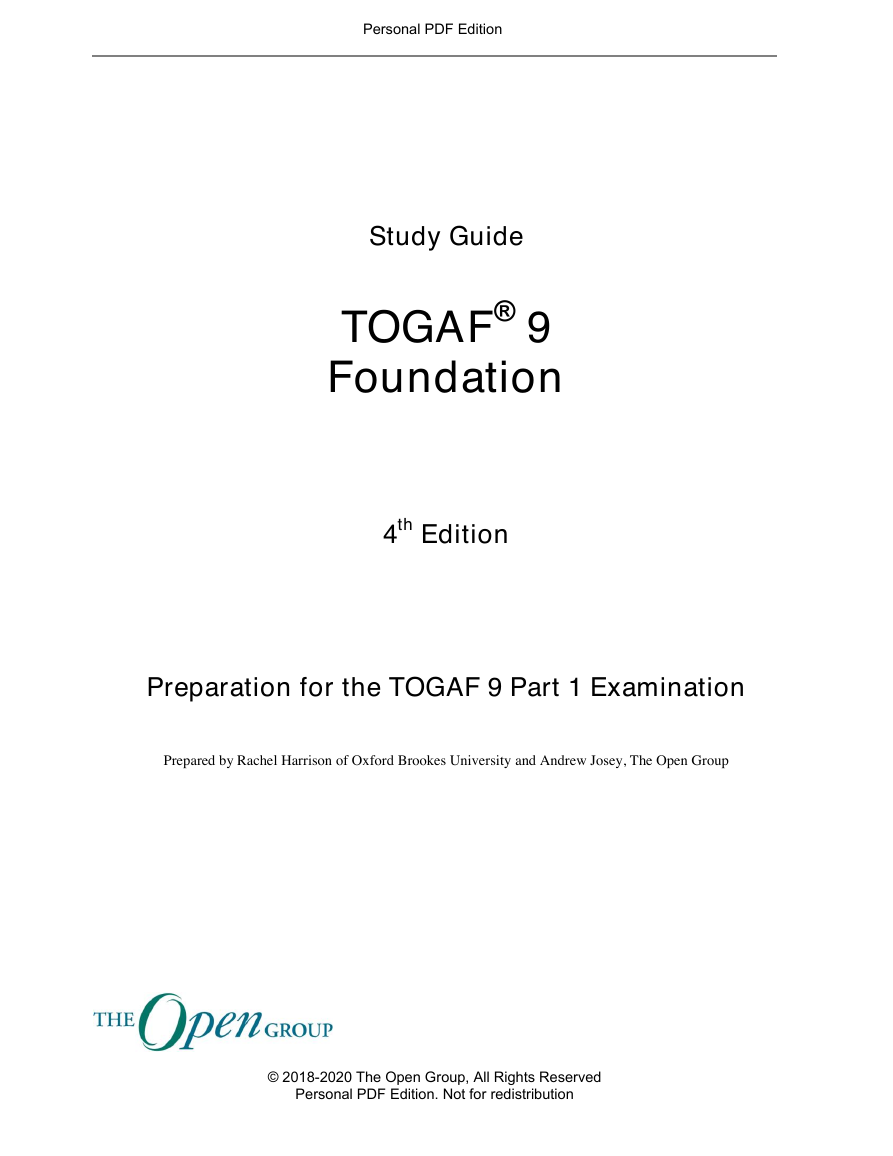

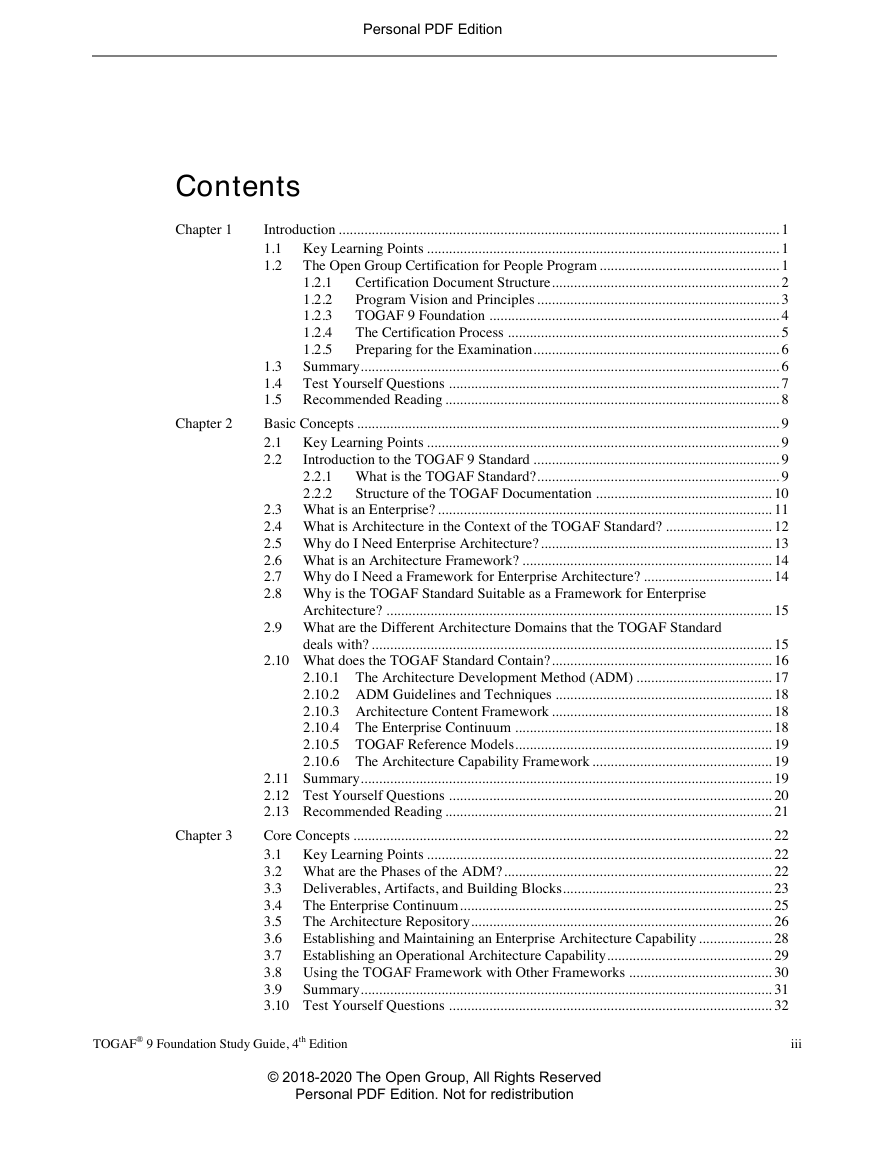
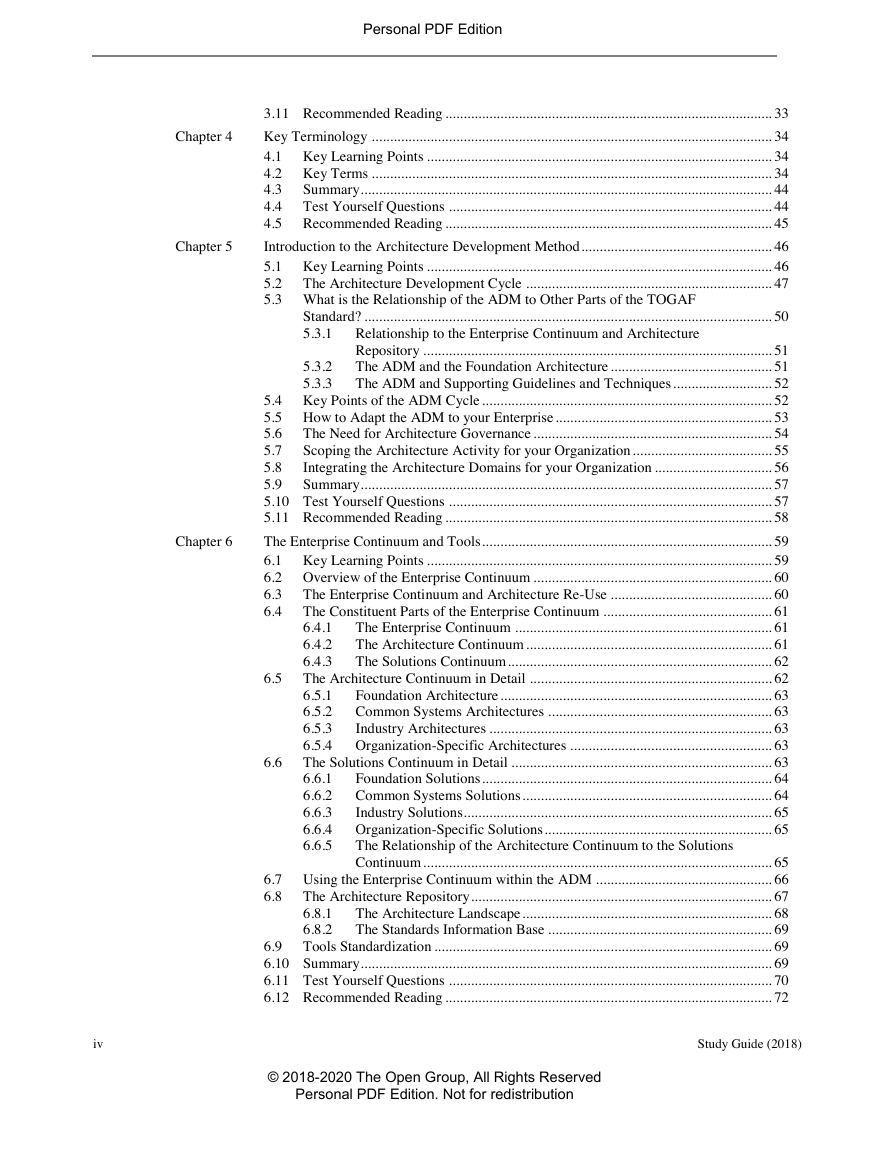
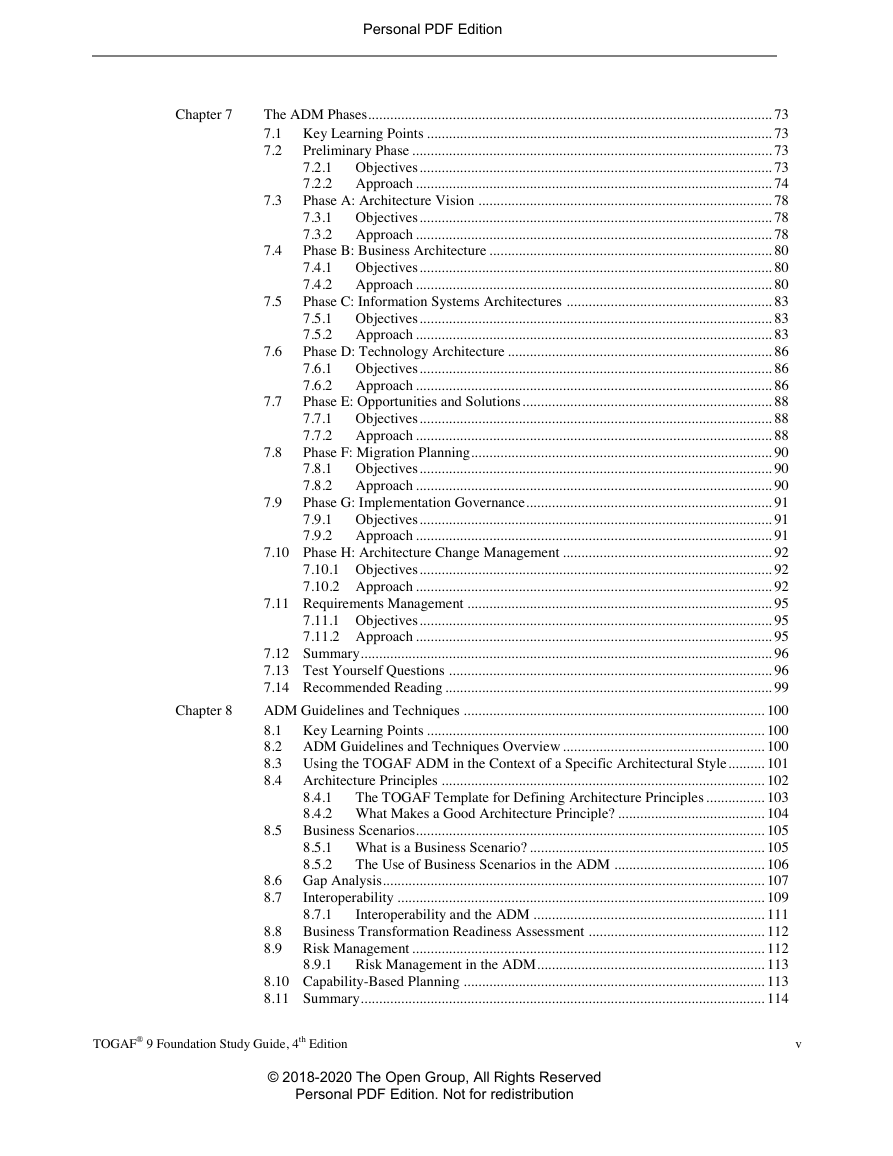
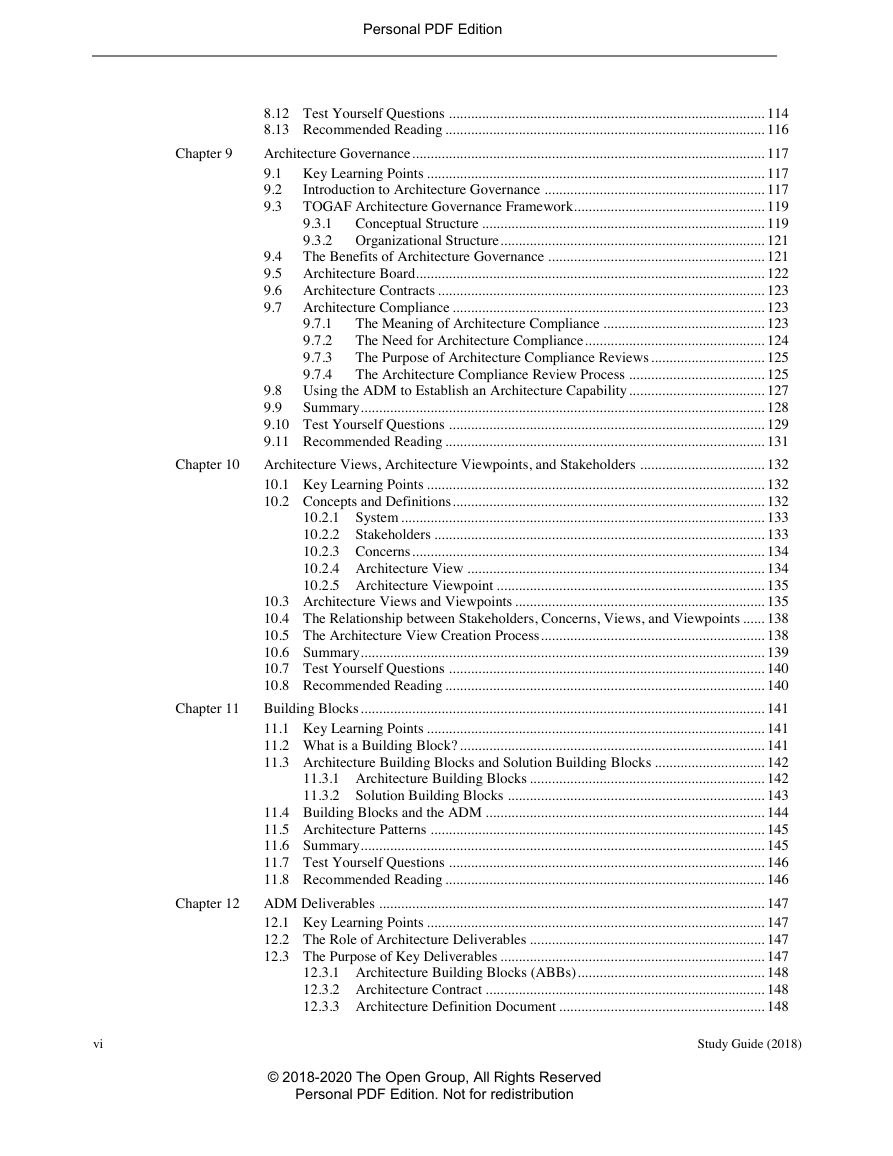
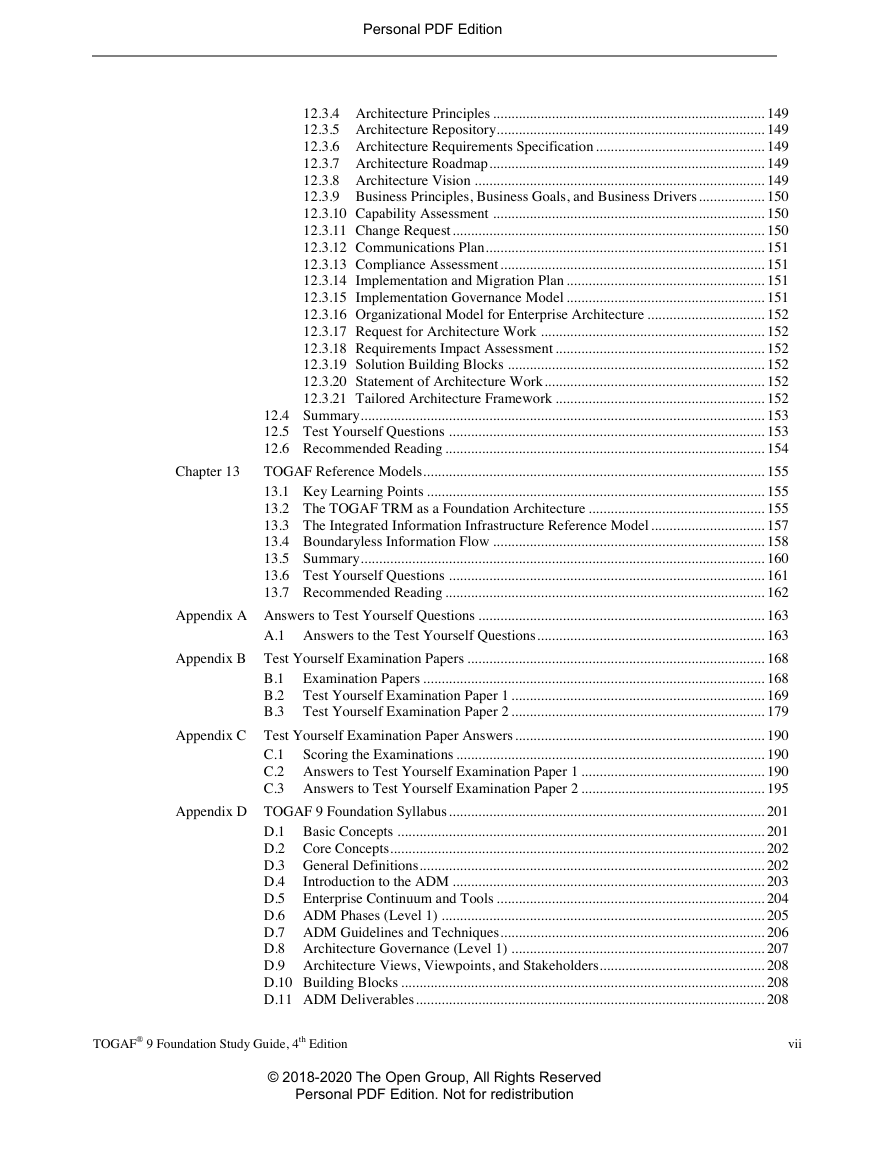
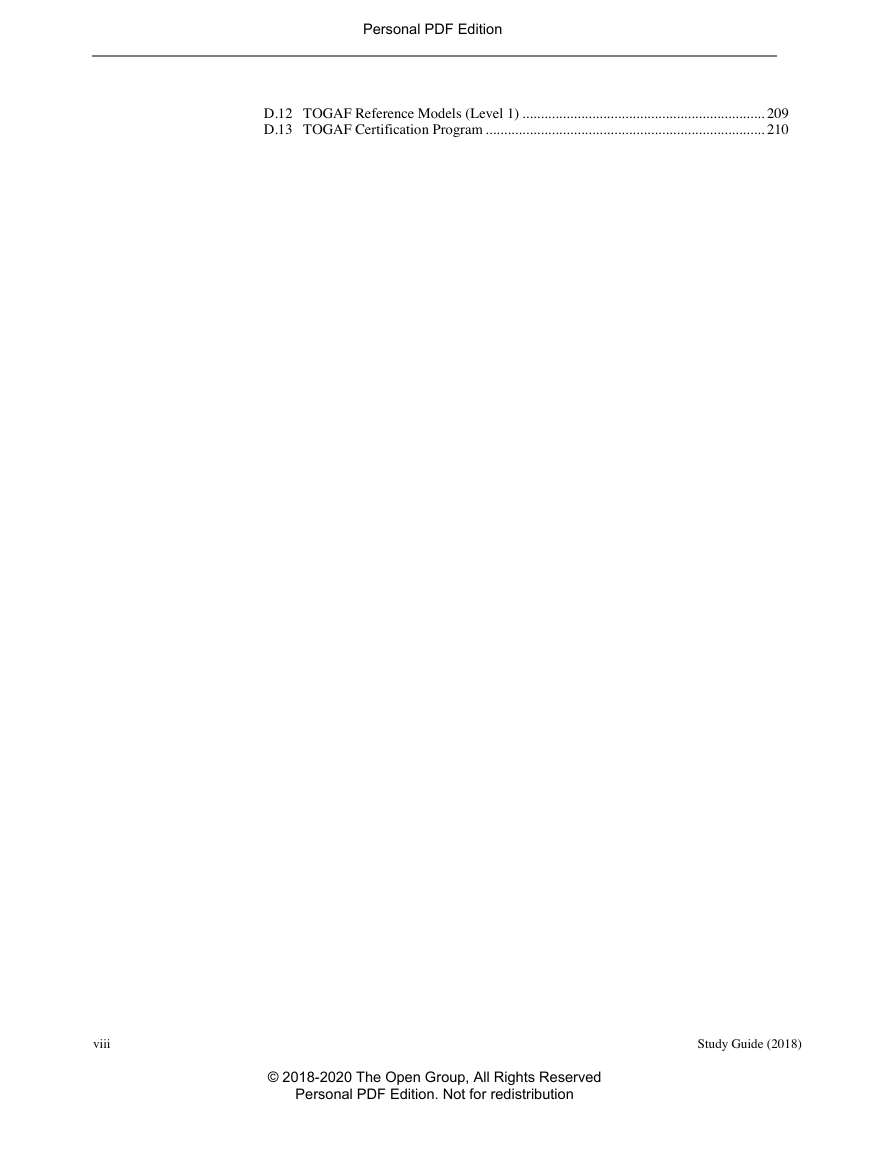








 2023年江西萍乡中考道德与法治真题及答案.doc
2023年江西萍乡中考道德与法治真题及答案.doc 2012年重庆南川中考生物真题及答案.doc
2012年重庆南川中考生物真题及答案.doc 2013年江西师范大学地理学综合及文艺理论基础考研真题.doc
2013年江西师范大学地理学综合及文艺理论基础考研真题.doc 2020年四川甘孜小升初语文真题及答案I卷.doc
2020年四川甘孜小升初语文真题及答案I卷.doc 2020年注册岩土工程师专业基础考试真题及答案.doc
2020年注册岩土工程师专业基础考试真题及答案.doc 2023-2024学年福建省厦门市九年级上学期数学月考试题及答案.doc
2023-2024学年福建省厦门市九年级上学期数学月考试题及答案.doc 2021-2022学年辽宁省沈阳市大东区九年级上学期语文期末试题及答案.doc
2021-2022学年辽宁省沈阳市大东区九年级上学期语文期末试题及答案.doc 2022-2023学年北京东城区初三第一学期物理期末试卷及答案.doc
2022-2023学年北京东城区初三第一学期物理期末试卷及答案.doc 2018上半年江西教师资格初中地理学科知识与教学能力真题及答案.doc
2018上半年江西教师资格初中地理学科知识与教学能力真题及答案.doc 2012年河北国家公务员申论考试真题及答案-省级.doc
2012年河北国家公务员申论考试真题及答案-省级.doc 2020-2021学年江苏省扬州市江都区邵樊片九年级上学期数学第一次质量检测试题及答案.doc
2020-2021学年江苏省扬州市江都区邵樊片九年级上学期数学第一次质量检测试题及答案.doc 2022下半年黑龙江教师资格证中学综合素质真题及答案.doc
2022下半年黑龙江教师资格证中学综合素质真题及答案.doc